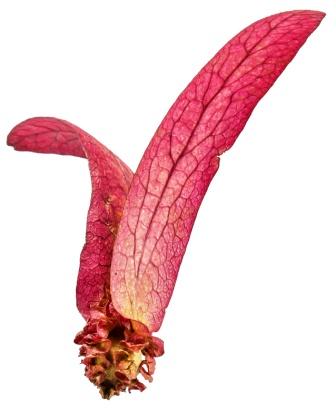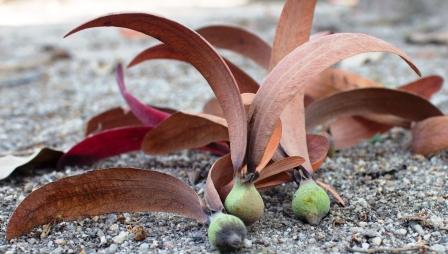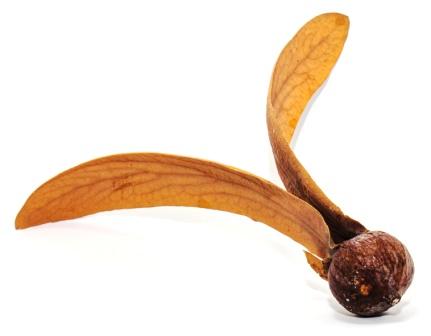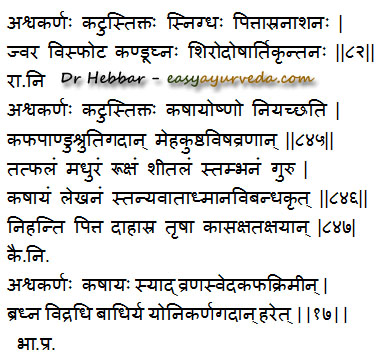Ashwakarna – Dipterocarpus turbinatus Uses, Research, Side Effects
Ashwakarna, Indian Gurjan – bark is used in treating abscess, urinary tract infection and hearing disorders. Its oil, called Gurjun balsam oil, is useful in skin disorders.
Botanical name– Dipterocarpus turbinatus Gaertn.f
Family- Dipterocarpaceae (Shala kula)
Table of Contents
Vernacular names
Names in different languages:
Bengali name- Teliya Garjan
English name- Common gurjun tree, Indian gurjan, gurjun, gurgina
Chinese name- jie bu luo xiang
Swedish name – keruing

Sanskrit Synonyms
Maricha Patraka – leaves resemble to those of black pepper
Jaranadruma,
Deerghaparna, Deergha patra – Elongated leaves
Deergha Vruksha – big tree
Kushika Taru, Kaushika, Aranya,
Ashvarohaka, Garjana, Jaranadrma, Kusika Taru

Distribution
Found in Assam, Meghalaya etc north eastern Indian states, Indonesia, Thailand, Cambodia, Bangladesh, Myanmar etc.
Major chemical constituents
Wood – Dipterocarpol, Oleoresin- Dammarenediol II, Betulonic acid, Etc
Essential oil- A-cadiena, a- Muurolene etc
Reference: Illustrated Dravyaguna VIjnana, Vol. II, by Dr JLN Shastry
Variety
Another tree, Dipterocarpus macrocarpus is also used in the name of Indian Gurjan. The Gurjan Balsam oil is also extracted from this tree.
Classical categorization
Charaka- Udarda Prashamana – group of herbs that are used in allergic skin conditions and ring worm infestation
Susruta- Salasaradi gana
Vagbhata- Udaraprasamana, Asandi Gana
Raja Nighantu – Prabhadradi Varga
Kaiyadeva Nighantu – Oshadhi Varga
Bhava Prakasha -Vatadi Varga

Medicinal properties
Guna (qualities) – Laghu – light to digest, Snigdha – unctuous, oily
Rasa (taste) – Katu (pungent), Tikta – bitter
Vipaka – Katu – Undergoes pungent taste conversion after digestion
Veerya – Ushna – Hot potency
Effect on Tridosha – balances Kapha and Vata Dosha.
Part used, dosage
Part used – Oil, bark, fruit
Dosage- bark powder 3-5 g
Sanskrit verse

Indicated in –
Pittasra – Raktapitta –Bleeding disorders such as nasal bleeding, heavy periods, etc
Jvara – fever
Sphota – boils, blisters
Kandu – itching, pruritus
Shirodosha – disorders of head
Shiro arti – headache
Pandu – anaemia
Shruti Gada – hearing disorders,
Meha – diabetes, urinary tract disorders
Kushta – skin diseases
Visha – Toxic conditions, poisoning
Vrana – Ulcers, wounds
Sweda – excess sweating
Krumi – worm infestation
Bradhna – Prolapsed rectum
Vidradhi – Abscess
Badhirya – deafness
Yonigada – Vaginal infection, excessive bleeding, uterine disorders
Karnagada – ear disorders
Fruit benefits, indications
Its fruit –
Madhura – sweet
Rooksha – dryness
Sheetala – coolant
Stambhana – blocks the channel, useful in diarrhea , bleeding disorders
Lekhana – has scraping property, useful in balancing Kapha, in respiratory disorders and in cholesterol / clot deposition in blood vessels
Stanyakrut –improves breast milk production
Indicated in
Adhmana – bloating, gaseous distension of abdomen
Raktapitta –Bleeding disorders such as nasal bleeding, heavy periods, etc
Trushna – excessive thirst
Kasa – cough, cold
Kshata – injury, bleeding
Kshaya – depletion of body tissues, weight loss, tuberculosis
The bark is especially used in urinary tract disorders. It is a good diuretic and antibacterial herb.
Its oil is called Gurjun balsam oil.
It is used in treating skin diseases with oral administration in a dose of up to 3 – 5 ml per day.
Side effects
It is best to avoid people with constipation.
Seek medical advice for its use during pregnancy and lactation.
Interaction with medicines, supplements
Can this be used while taking Homeopathic medicine?
Yes. This product does not react with homeopathic medicine.
Can this medicine be continued while taking supplements like multivitamin tablets, Omega 3 fatty acids etc?
Yes. Generally, this product goes well with most dietary supplements. However, if you are taking more than one product per day, please consult your doctor for an opinion.
With western
medicines
Seek your
doctor’s advice if you are taking this product along with other western
(allopathic / modern) medicines. Some Ayurvedic herbs can interact with modern
medicine.
If both Ayurvedic and allopathic medicines are advised together, then it is
best to take Allopathic medicine first, wait for 30 minutes and then take the
Ayurvedic medicine.
Sthanika Karma (Systemic Action)
External Application – Oil is used for external applications in skin disorders
Internal administration-
Excretory system – Its action is mainly on mutravaha srotas, Increases the urine output. Its oil with milk is indicated in chronic UTI.
Tvak – Indicated in skin diseases










